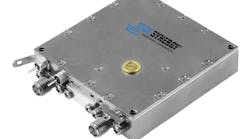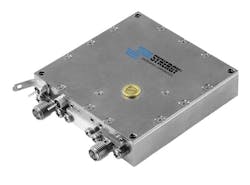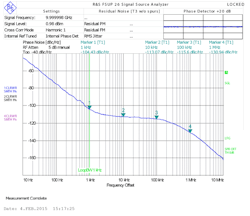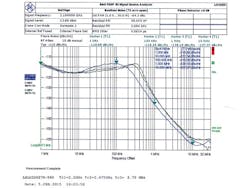Novel ASIC Helps Sources Silence Noise
This file type includes high resolution graphics and schematics when applicable.
Phase noise is a critical performance parameter in many applications—from communications to radar systems, and from commercial to military uses—and techniques that generate RF/microwave signals while minimizing phase noise are always of interest.
Synergy Microwave Corp. has long been associated with low-noise RF/microwave signal sources and novel techniques for signal generation. The firm has now developed a phase-locked synthesizer and fixed-frequency, phase-locked-oscillator (PLO) design that can be applied to the generation of low-noise fundamental-frequency signal sources from 100 MHz to 15 GHz—and extendable to 30 GHz , when using an external frequency doubler from Synergy. Even more remarkable, these quiet signal sources fit within compact industry-standard 2.25 × 2.25-in. module housings, or on a 1.0 × 1.25 in. surface-mount-technology (SMT) footprint.
The low-noise PLO/synthesizer connectorized module version (Fig. 1) and surface-mount version build upon a unique state-of-the-art phase-lock-loop (PLL) application-specific-integrated-circuit (ASIC) device—one that enables extremely high frequency range and versatile divider/phase-detector flexibility for phase-locking RF and microwave signal sources. These include dielectric-resonator oscillators (DROs) and various-topology voltage-controlled oscillators (VCOs). The proprietary ASIC makes it possible to phase lock these and other wide-band, high-frequency oscillators with bandwidths beyond octave tuning.
These synthesizers or fixed LO sources can lock to almost any reference source even through microwave frequencies, such as stable crystal oscillators and multiples thereof, and can function effectively in a number of different operating modes. The ASIC makes an excellent, low-noise starting point for such component functions as high-frequency dividers and phase detectors, as well as phase-locked fixed-frequency and tunable frequency sources.
The PLL design supports both single- and dual-loop modes of operation with a wide array of reference sources. In single-loop mode of operation, for example, it can work with reference frequencies from 1 MHz to as high as 2.2 GHz, enabling the addition of a synthesized single-loop frequency source to a wide range of systems. In dual-loop mode of operation, the PLL ASIC can lock a first-loop reference crystal/frequency-multiplier combination to supply an output, second-loop PLL a reference frequency signal up to 1 GHz.
The ASIC enables particularly low single-sideband (SSB) phase noise from both the single- and dual-loop source configurations with the industry-leading lowest noise digital divider and phase detector. Measurements taken with a model FSUP signal source analyzer from Rohde & Schwarz for a 10-GHz dual-loop synthesizer at 10 GHz show the excellent loop noise performance and sharp drop in phase noise further from the carrier using a low-noise voltage-tuned DRO from Synergy (Fig. 2).
A frequency-synthesizer PLO module with this ASIC can be used to construct dual-loop phase-locked DROs to 14.5 GHz as well as dual-loop frequency synthesizers in octave bands to 10 GHz, these latter sources with frequency settling times of less thanâ¨100 μs. Either of these dual-loop configurations can also accommodate virtually any reference frequency. Dual-loop capability also offers the benefit of reference cleanup of unwanted spurious signal products and noise that may exist on a necessary reference time standard.
The initial primary loop’s narrow bandwidth and excellent crystal or surface-acoustic-wave (SAW) oscillator noise performance—coupled with the lowest available digital phase detector noise floor—yields performance only previously seen using analog samplers or fundamental mixer/phase-detector techniques. Fixed and Frequency Agile models are both available with dual output or coupled sample output. Modules can also be configured to output a reference or internal first loop sample.
Both connectorized single KSLSO and dual-loop KDSLO versions communicate using a simple channel-select SPI connection. Custom program interfaces are also available to suit specific interface applications. It is only necessary to communicate with one channel-select register.
This file type includes high resolution graphics and schematics when applicable.
A Smaller Footprint
This file type includes high resolution graphics and schematics when applicable.
Working much the same as the modular connectorized versions, the PLL ASIC has also been integrated within smaller SMT frequency-synthesizer products, in a compact 1.0 × 1.25 in. footprint. The single-loop surface-mount version is designed for use with input frequencies to 2.2 GHz and supplying stable, low-noise octave-band output signals to about 10 GHz. This surface-mount footprint (Fig. 3) has been used to accommodate a custom VCO for radar and communications-band frequencies. For this particular custom design, moderately wide locked bandwidths are achieved by using one of Synergy’s low-noise, wide-tuning-range microstrip VCO designs. For sources requiring reference frequencies below 100 MHz, internal low-noise reference multiplying techniques are employed to achieve the highest possible phase detector operating rate for best output noise performance that takes advantage of the PLL ASIC’s unique capabilities.
As an example of the source performance possible from synthesizers employing this novel ASIC in a single-loop configuration, model LSLO220270-500 is a phase-locked frequency synthesizer that delivers a 500-MHz output bandwidth from 2200 to 2700 MHz. It is designed to work with an 80-MHz frequency reference at +5 dBm and fits within the smaller 1.0 × 1.25-in. SMT housing. This RoHS-compliant frequency synthesizer tunes in 5-MHz steps and provides at least +8-dBm output power across its 500-MHz tuning range.
It achieves -23 dBc typical second-harmonic suppression with impressive SSB phase-noise performance (Fig. 4). Spurious noise levels are typically -65 dBc or better. The phase noise is a low -118 dBc/Hz even as close as 1 kHz from the carrier, dropping to -123 dBc/Hz offset 10 kHz from the carrier, better than -135 dBc/Hz offset 1 MHz from the carrier, and -155 dBc/Hz or less for offset frequencies beyond 1 MHz from the carrier. The signal source can be programmed by means of serial peripheral interface (SPI) or parallel port and features settling time within 100 μs to a new frequency when programmed with SPI fast-lock mode.
The 2.2-to-2.7-GHz source draws no more than 100 mA current from a +5-VDC supply and tunes by means of a +12-VDC source, drawing no more than 60 mA current. A +3,3-VDC digital supply draws maximum current of 550 mA. The 2.2-to2.7-GHz source is designed for an operating temperature range of -30 to +70°C.
The surface-mount SLSO and SLFO sources also communicate using the simple channel-select SPI command interface. The surface-mount version can accommodate a limited channel number parallel interface using as many as seven parallel interface lines.
As with the company’s other single-loop and dual-loop phase-locked SMT source designs and VCO products, the 2.2-to-2.7-GHz frequency synthesizer employs the firm’s patented REL-PRO technology for reliable surface-mount electrical connections. The approach avoids the use of contacts with castellations, which are larger-diameter plated-through holes (PTHs) formed through printed-circuit boards (PCBs) to make electrical contacts and signal transitions between two or more PCBs in an assembly.
Since REL-PRO contacts do not critically depend upon the punching, routing, and alignment measures employed in forming castellation contacts, higher yields with more reliable contacts are possible with REL-PRO contacts than with standard PTH multiple-PCB connections. Unlike PCBs formed through a castellation process, the REL-PRO process does not produce the exposed copper from punching or routing PTHs. Without exposed copper, there is less concern about the long-term reliability problems resulting from oxidation and corrosion of that exposed copper.
The product lines of frequency synthesizers and phase-locked oscillators using this new ASIC are suitable for a wide range of applications through 15 GHz, including in microwave radios, satellite-communications (satcom) systems, radar systems, and test equipment. The sources are available for a standard operating-temperature range of -10 to +60°C and with an extended operating temperature range of -40 to +85°C also available. For single-loop and dual-loop frequency synthesizers, the standard connectorized module size is 2.5 × 2.5 × 0.5 in.
The frequency synthesizers provide standard output-power levels to +12 dBm, with optional output power to +16 dBm also available. The synthesized signal sources can be designed with dual RF/microwave frequency outputs or with a reference sample output in addition to the standard frequency output.
Synergy Microwave Corp., 201 McLean Blvd., Paterson, NJ 07504; (973) 881-8800, FAX: (973) 881-8361
This file type includes high resolution graphics and schematics when applicable.





